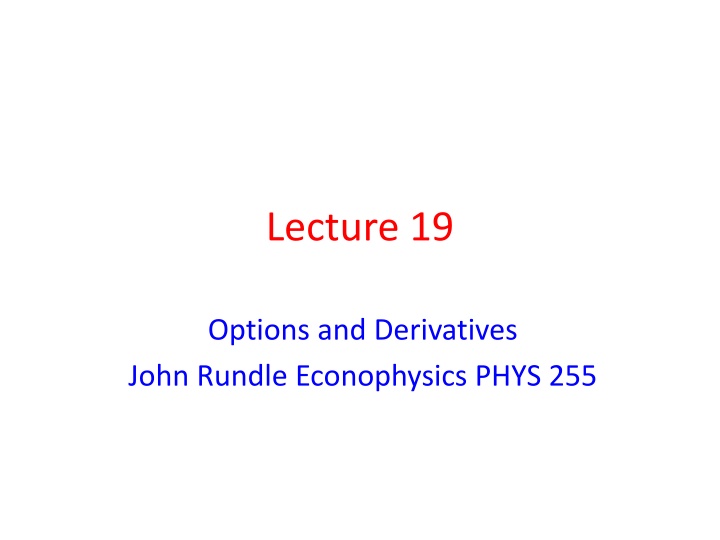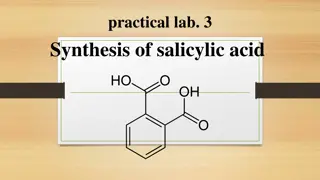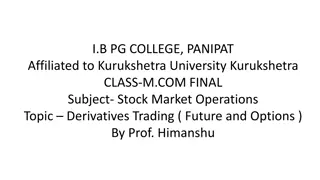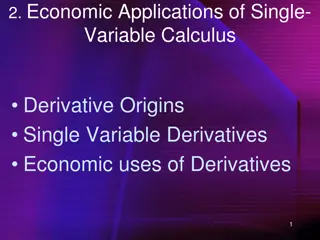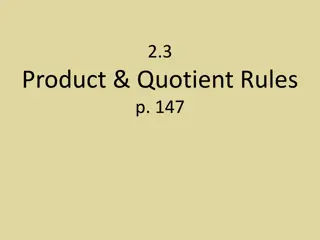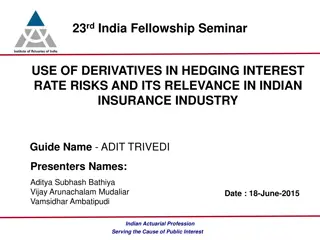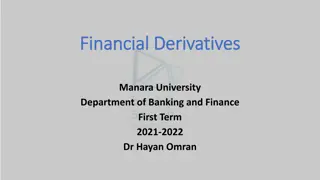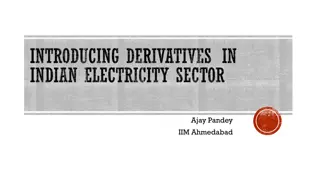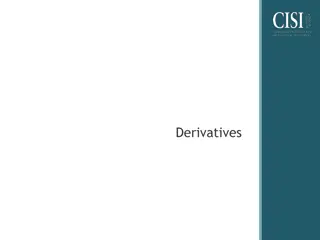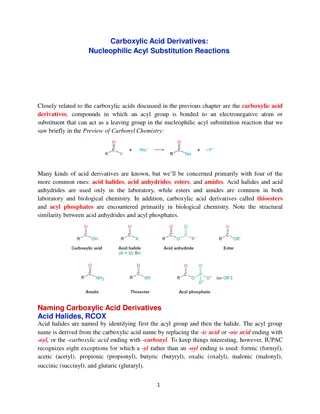Options and Derivatives in Finance
Dive into the world of options and derivatives in finance, where contracts derive value from underlying assets. Explore the basics of options trading, from call and put options to exercising and expiration. Understand how derivatives can be used for hedging, speculation, and accessing unique assets or markets. Discover the intricacies of options pricing and the dynamics of options trading in financial markets.
Download Presentation

Please find below an Image/Link to download the presentation.
The content on the website is provided AS IS for your information and personal use only. It may not be sold, licensed, or shared on other websites without obtaining consent from the author.If you encounter any issues during the download, it is possible that the publisher has removed the file from their server.
You are allowed to download the files provided on this website for personal or commercial use, subject to the condition that they are used lawfully. All files are the property of their respective owners.
The content on the website is provided AS IS for your information and personal use only. It may not be sold, licensed, or shared on other websites without obtaining consent from the author.
E N D
Presentation Transcript
Lecture 19 Options and Derivatives John Rundle Econophysics PHYS 255
Derivatives https://en.wikipedia.org/wiki/Derivative_(finance) In finance, a derivative is a contract that derives its value from the performance of an underlying entity. This underlying entity can be an asset, index, or interest rate, and is often simply called the "underlying." Derivatives can be used for a number of purposes, including insuring against price movements (hedging), increasing exposure to price movements for speculation or getting access to otherwise hard-to-trade assets or markets. Some of the more common derivatives include forwards, futures, options, swaps, and variations of these such as synthetic collateralized debt obligations and credit default swaps.
Options: Basics https://en.wikipedia.org/wiki/Option_(finance) In finance, an option is a contract which gives the buyer (the owner or holder of the option) the right, but not the obligation, to buy or sell an underlying asset or instrument at a specified strike price on a specified date, depending on the form of the option. The strike price may be set by reference to the spot price (market price) of the underlying security or commodity on the day an option is taken out, or it may be fixed at a discount or at a premium. The seller has the corresponding obligation to fulfill the transaction to sell or buy if the buyer (owner) "exercises" the option.
Options: Basics https://en.wikipedia.org/wiki/Option_(finance) An option that conveys to the owner the right to buy at a specific price is referred to as a call An option that conveys the right of the owner to sell at a specific price is referred to as a put. Both are commonly traded, but the call option is more frequently discussed. The seller may grant an option to a buyer as part of another transaction, such as a share issue or as part of an employee incentive scheme, otherwise a buyer would pay a premium to the seller for the option. A call option would normally be exercised only when the strike price is below the market value of the underlying asset at the time of purchase of the option A put option would normally be exercised only when the strike price is above the market value at the time of purchase
Options: Basics https://en.wikipedia.org/wiki/Option_(finance) When an option is exercised, the cost to the buyer of the asset acquired is the strike price plus the premium, if any. When the option expiration date passes without the option being exercised, then the option expires, and the buyer would forfeit the premium to the seller. In any case, the premium is income to the seller, and normally a capital loss to the buyer. The owner of an option may sell the option to a third party in a secondary market, in either an over-the-counter transaction or on an options exchange, depending on the option In general, the pricing mechanism for options implies that only a fraction of about 1/e of the options are ever exercised
Options: Basics https://en.wikipedia.org/wiki/Option_(finance) The market price of an American-style option normally closely follows that of the underlying stock, being the difference between the market price of the stock and the strike price of the option. The actual market price of the option may vary depending on a number of factors, such as: A significant option holder may need to sell the option as the expiry date is approaching and does not have the financial resources to exercise the option, or A buyer in the market is trying to amass a large option holding. If the strike price is far above or below the current spot price If the option has a long time until expiration The ownership of an option does not generally entitle the holder to any rights associated with the underlying asset, such as voting rights or any income from the underlying asset, such as a dividend.
Options: Basics https://en.wikipedia.org/wiki/Option_(finance) In the real estate market, call options have long been used to assemble large parcels of land from separate owners As an example, a developer pays for the right to buy several adjacent plots but is not obligated to buy these plots and might not unless he can buy all the plots in the entire parcel. Film or theatrical producers often buy the right but not the obligation to dramatize a specific book or script. Lines of credit give the potential borrower the right but not the obligation to borrow within a specified time period. Many choices, or embedded options, have traditionally been included in bond contracts. For example, many bonds are convertible into common stock at the buyer's option or may be called (bought back) at specified prices at the issuer's option. Mortgage borrowers have long had the option to repay the loan early, which corresponds to a callable bond option.
Options: Basics https://en.wikipedia.org/wiki/Option_(finance) Options contracts have been known for decades. The Chicago Board Options Exchange (CBOE) was established in 1973, which set up a regime using standardized forms and terms and trade through a guaranteed clearing house. Trading activity and academic interest has increased since then. Today, many options are created in a standardized form and traded through clearing houses on regulated options exchanges Other over-the-counter options are written as bilateral, customized contracts between a single buyer and seller, one or both of which may be a dealer or market-maker.
To Summarize An option is a contract that gives the buyer of it to purchase or sell 100 shares of a stock, ETF, bond, or other security at a specified price ( strike price ) rather than the current price ( spot price ) There are 2 types of options: A call option , which gives the buyer the right to buy the 100 shares at the strike price A put option , which gives the buyer the right to sell 100 shares at the strike price You can either buy or sell options, the cost is the premium If you buy a call option, you can use it ( exercise it") only when the spot price rises above the strike price If you buy a put option, you can exercise it only when the spot price falls below the strike price There is a time limit on the option ( expiration date ) American options can be used at any time, European options can only be used at the expiration date The buyer can in principle make an unlimited amount of money, equal to the difference between the strike price and the spot price, minus the premium The seller can lose an amount of money equal to the difference between the strike price and the spot price minus the premium, the most they can make is the premium
Option Styles https://en.wikipedia.org/wiki/Option_(finance) American option an option that may be exercised on any trading day on or before expiration. European option an option that may only be exercised on expiry. These are often described as vanilla options. Other styles include: Bermudan option an option that may be exercised only on specified dates on or before expiration. Asian option an option whose payoff is determined by the average underlying price over some preset time period. Barrier option any option with the general characteristic that the underlying security's price must pass a certain level or "barrier" before it can be exercised. Binary option An all-or-nothing option that pays the full amount if the underlying security meets the defined condition on expiration otherwise it expires. Exotic option any of a broad category of options that may include complex financial structures.
Contract Specifications https://en.wikipedia.org/wiki/Option_(finance) A financial option is a contract between two counterparties with the terms of the option specified in a term sheet. Option contracts may be quite complicated; however, at minimum, they usually contain the following specifications: whether the option holder has the right to buy (a call option) or the right to sell (a put option) the quantity and class of the underlying asset(s) (e.g., 100 shares of XYZ Co. B stock) the strike price, also known as the exercise price, which is the price at which the underlying transaction will occur upon exercise the expiration date, or expiry, which is the last date the option can be exercised the settlement terms, for instance whether the writer (seller) must deliver the actual asset on exercise, or may simply tender the equivalent cash amount the terms by which the option is quoted in the market to convert the quoted price into the actual premium the total amount paid by the holder (buyer) to the writer (seller)
Options Trading https://en.wikipedia.org/wiki/Option_(finance) Exchange-traded options (also called "listed options") are a class of exchange- traded derivatives. Exchange traded options have standardized contracts and are settled through a clearing house with fulfillment guaranteed by the Options Clearing Corporation (OCC). Since the contracts are standardized, accurate pricing models are often available. Exchange-traded options include: stock options bond options and other interest rate options stock market index options or, simply, index options and options on futures contracts
Over the Counter Trades https://en.wikipedia.org/wiki/Option_(finance) Over-the-counter options (OTC options, also called "dealer options") are traded between two private parties and are not listed on an exchange. The terms of an OTC option are unrestricted and may be individually tailored to meet any business need. In general, the option writer (seller) is a well-capitalized institution (in order to prevent credit risk). Option types commonly traded over the counter include: interest rate options currency cross rate options, and options on swaps or swaptions (options on swaps such as currency swaps or interest rate swaps).
Over the Counter Trades https://en.wikipedia.org/wiki/Option_(finance) By avoiding an exchange, users of OTC options can narrowly tailor the terms of the option contract to suit individual business requirements. In addition, OTC option transactions generally do not need to be advertised to the market and face little or no regulatory requirements. However, OTC counterparties must establish credit lines with each other and conform to each other's clearing and settlement procedures. With few exceptions, there are no secondary markets for employee stock options, such as those issued by start-up companies. These must either be exercised by the original grantee or allowed to expire.
Exchange Trading https://en.wikipedia.org/wiki/Option_(finance) The most common way to trade options is via standardized options contracts that are listed by various futures and options exchanges. Listings and prices are tracked and can be looked up by ticker symbol. By publishing continuous, live markets for option prices, an exchange enables independent parties to engage in price discovery and execute transactions. As an intermediary to both sides of the transaction, benefits the exchange provides to the transaction include: fulfillment of the contract is backed by the credit of the exchange (clearing house), which typically has the highest rating (AAA), counterparties remain anonymous, enforcement of market regulation to ensure fairness and transparency, and maintenance of orderly markets, especially during fast trading conditions.
Terminology Long The buyer of the option Short The seller of the option Call A bet that the price will go up Put A bet that the price will go down
Current spot price: 237.89 SPY Options (March 6, 2017, 10:30 am) In the money means that a call option's strike price is below the market or current spot price of the underlying asset or that the strike price of a put option is above the market price Open interest will tell you the total number of option contracts that are currently open - in other words, contracts that have been traded but not yet liquidated by either an offsetting trade or an exercise or assignment. Volume is the number of contracts traded in a given period
American Options: Payoff Diagram https://en.wikipedia.org/wiki/Option_(finance) Share Price You bought These trades are described from the point of view of a buyer. If they are combined with other positions, they can also be used in hedging. An option contract in US markets usually represents 100 shares of the underlying security.
Long Call (You bought the Call) https://en.wikipedia.org/wiki/Option_(finance) A trader who expects a stock's price to increase can buy a call option to purchase the stock at a fixed price ("strike price") at a later date, rather than purchase the stock outright. The cash outlay on, or price paid for, the option is the premium. The trader would have no obligation to buy the stock but only has the right to do so at or before the expiration date. The risk of loss would be limited to the premium paid, unlike the possible loss had the stock been bought outright. Risk of loss to the seller of an option is potentially unlimited, however
Long Call (You bought the Call) https://en.wikipedia.org/wiki/Option_(finance) The holder of an American style call option can sell his option holding at any time until the expiration date and would consider doing so when the stock's spot price is above the exercise price, especially if she expects the price of the option to drop. By selling the option early in that situation, the trader can realize an immediate profit. Alternatively, she can exercise the option for example, if there is no secondary market for the options and then sell the stock, realizing a profit. A trader would make a profit if the spot price of the shares rises by more than the premium.
Long Call (You bought the Call) https://en.wikipedia.org/wiki/Option_(finance) For example, if the exercise price is 100 and premium paid is 10, then if the spot price of 100 rises to only 110 the transaction is break-even An increase in stock price above 110 produces a profit. If the stock price at expiration is lower than the exercise price, the holder of the options at that time will let the call contract expire and only lose the premium (or the price paid on transfer). Share Price From the point of view of the buyer of the call option
Long Put (You bought the Put) https://en.wikipedia.org/wiki/Option_(finance) A trader who expects a stock's price to decrease can buy a put option to sell the stock at a fixed price (the "strike price") at a later date. The trader will be under no obligation to sell the stock, but only has the right to do so at or before the expiration date. If the stock price at expiration is below the exercise price by more than the premium paid, he will make a profit. If the stock price at expiration is above the exercise price, he will let the put contract expire and only lose the premium paid. In the transaction, the premium also plays a major role as it enhances the break-even point. The seller of the option is obligated to deliver the security to the buyer at the agreed and contracted strike price if the option is exercised or to deliver cash to the buyer
Long Put (You bought the Put) https://en.wikipedia.org/wiki/Option_(finance) For example, if exercise (strike) price is 100, premium paid is 10, then a spot price of 100 to 90 is not profitable. He would make a profit if the spot price is below 90. It is important to note that one who exercises a put option, does not necessarily need to own the underlying asset. Specifically, one does not need to own the underlying stock in order to sell it or profit from the option Share Price From the point of view of the buyer of the put option
Short Call (You sold the Call) https://en.wikipedia.org/wiki/Option_(finance) A trader who expects a stock's price to decrease can sell the stock short or instead sell, or "write", a call. The trader selling a call has an obligation to sell the stock to the call buyer at a fixed price ("strike price"). If the seller does not own the stock when the option is exercised, he is obligated to purchase the stock from the market at the then market price. If the stock price decreases, the seller of the call (call writer) will make a profit in the amount of the premium. If the stock price increases over the strike price by more than the amount of the premium, the seller will lose money, with the potential loss being unlimited, the difference between the spot price and the strike price Maximum profit the seller can make is the premium Share Price From the point of view of the seller or writer of the call option
A trader who expects a stock's price to increase can buy the stock or instead sell, or "write", a put. The trader selling a put has an obligation to buy the stock from the put buyer at a fixed price ("strike price"). If the stock price at expiration is above the strike price, the seller of the put (put writer) will make a profit in the amount of the premium. If the stock price at expiration is below the strike price by more than the amount of the premium, the trader will lose money, with the potential loss being the difference between the spot and strike price, minus the premium. The potential loss is unlimited, however A benchmark index for the performance of a cash-secured short put option position is the CBOE S&P 500 PutWrite Index (ticker PUT). Short Put (You sold the Put) https://en.wikipedia.org/wiki/Option_(finance) Maximum profit the seller can make is the premium Share Price From the point of view of the seller or writer of the put option
Option Strategies https://en.wikipedia.org/wiki/O ption_(finance) Combining any of the four basic kinds of option trades (possibly with different exercise prices and maturities) and the two basic kinds of stock trades (long and short) allows a variety of options strategies. Simple strategies usually combine only a few trades, while more complicated strategies can combine several. Strategies are often used to engineer a particular risk profile to movements in the underlying security. For example, buying a butterfly spread (long one X1 call, short two X2 calls, and long one X3 call) allows a trader to profit if the stock price on the expiration date is near the middle exercise price, X2, and does not expose the trader to a large loss. Butterfly Spread X2 X3 X1 From the point of view of the trader or buyer of the options An Iron condor is a strategy that is similiar to a butterfly spread, but with different strikes for the short options offering a larger likelihood of profit but with a lower net credit compared to the butterfly spread.
Option Strategies https://en.wikipedia.org/wiki/O ption_(finance) One well-known strategy is the covered call, in which a trader buys a stock (or holds a previously- purchased long stock position), and sells a call. If the stock price rises above the exercise price, the call will be exercised, and the trader will get a fixed profit. If the stock price falls, the call will not be exercised, and any loss incurred to the trader will be partially offset by the premium received from selling the call. Overall, the payoffs match the payoffs from selling a put. This relationship is known as put- call parity The covered call is a simple hedging strategy
Option Strategies https://en.wikipedia.org/wiki/Option_(finance) Another very common strategy is the protective put, in which a trader buys a stock (or holds a previously-purchased long stock position) and buys a put. This strategy acts as an insurance when investing on the underlying stock, hedging the investor's potential loses, but also shrinking an otherwise larger profit, if just purchasing the stock without the put. The maximum profit of a protective put is theoretically unlimited as the strategy involves being long on the underlying stock. The maximum loss is limited to the purchase price of the underlying stock less the strike price of the put option and the premium paid.
Valuation Overview https://en.wikipedia.org/wiki/Option_(finance) Options valuation is a topic of ongoing research in academic and practical finance. In basic terms, the value of an option is commonly decomposed into two parts: The first part is the intrinsic value, which is defined as the difference between the market value of the underlying, and the strike price of the given option The second part is the time value, which depends on a set of other factors which, through a multi-variable, non-linear interrelationship, reflect the discounted expected value of that difference at expiration. Although options valuation has been studied at least since the nineteenth century, the contemporary approach is based on the Black Scholes model which was first published in 1973.
Valuation Models https://en.wikipedia.org/wiki/Option_(finance) The value of an option can be estimated using a variety of quantitative techniques based on the concept of risk neutral pricing and using stochastic calculus, the most basic model being the Black Scholes model (which we shall discuss). In general, standard option valuation models depend on the following factors: The current market price of the underlying security, The strike price of the option, particularly in relation to the current market price of the underlying (in the money vs. out of the money), The cost of holding a position in the underlying security, including interest and dividends, The time to expiration together with any restrictions on when exercise may occur, and An estimate of the future volatility of the underlying security's price over the life of the option.
Valuation Models: Black-Scholes https://en.wikipedia.org/wiki/Option_(finance) Following early work by Louis Bachelier and later work by Robert C. Merton, Fischer Black and Myron Scholes made a major breakthrough by deriving a differential equation that must be satisfied by the price of any derivative dependent on a non-dividend-paying stock. By employing the technique of constructing a risk neutral portfolio that replicates the returns of holding an option, Black and Scholes produced a closed-form solution for a European option's theoretical price (discussed in next lecture) At the same time, the model generates hedge parameters necessary for effective risk management of option holdings. The ideas behind the Black Scholes model were ground-breaking and eventually led to Scholes and Merton receiving the Nobel Prize in Economics The application of the model in actual options trading is clumsy because of the assumptions of continuous trading, constant volatility, and a constant interest rate.
Black-Scholes Calculator http://www.fintools.com/resources/online-calculators/options-calcs/options-calculator/ Screen Shot 2017-02-07 at 2.57.38 PM.png Fincalc login in files
Valuation Models: Stochastic Volatility https://en.wikipedia.org/wiki/Option_(finance) Since the market crash of 1987, it has been observed that market implied volatility for options of lower strike prices are typically higher than for higher strike prices This suggests that volatility is stochastic, varying both for time and for the price level of the underlying security. (ARCH and GARCH models) Stochastic volatility models have been developed including one developed by S.L. Heston. One principal advantage of the Heston model is that it can be solved in closed-form, while other stochastic volatility models require complex numerical methods.
Valuation Models: Binomial Tree https://en.wikipedia.org/wiki/Option_(finance) This model starts with a binomial tree of discrete future possible underlying stock prices. Then it models the dynamics of the option's theoretical value for discrete time intervals over the option's life. By constructing a riskless portfolio of an option and stock (as in the Black Scholes model) a simple formula can be used to find the option price at each node in the tree. This value can approximate the theoretical value produced by Black Scholes, to the desired degree of precision. However, the binomial model is considered more accurate than Black Scholes because it is more flexible; e.g., discrete future dividend payments can be modeled correctly at the proper forward time steps, and American options can be modeled as well as European ones. Binomial models are widely used by professional option traders
Valuation Models: Monte Carlo https://en.wikipedia.org/wiki/Option_(finance) For many classes of options, traditional valuation techniques are intractable because of the complexity of the instrument. In these cases, a Monte Carlo approach may often be useful. Rather than attempt to solve the differential equations of motion that describe the option's value in relation to the underlying security's price, a Monte Carlo model uses simulation to generate random price paths of the underlying asset, each of which results in a payoff for the option. The average of these payoffs can be discounted to yield an expectation value for the option. Note though, that despite its flexibility, using simulation for American styled options is somewhat more complex than for lattice-based models.
Valuation Models: Finite Difference https://en.wikipedia.org/wiki/Option_(finance) The equations used to model the option are often expressed as partial differential equations (see for example Black Scholes equation). Once expressed in this form, a finite difference model can be derived, and the valuation obtained. A number of implementations of finite difference methods exist for option valuatio, including explicit finite difference, implicit finite difference and the Crank- Nicholson method. A trinomial tree option pricing model can be shown to be a simplified application of the explicit finite difference method. Although the finite difference approach is mathematically sophisticated, it is particularly useful where changes are assumed over time in model inputs for example dividend yield, risk free rate, or volatility, or some combination of these that are not tractable in closed form.
Bitcoin Options Open Interest 1/26/2023 https://www.deribit.com/statistics/BTC/options-data
Bitcoin Options Open Interest 11/20/2024 https://www.deribit.com/statistics/BTC/options-data Expiry: 2024-12-27 Current Spot Price: ~$94,500 11/20/2024
